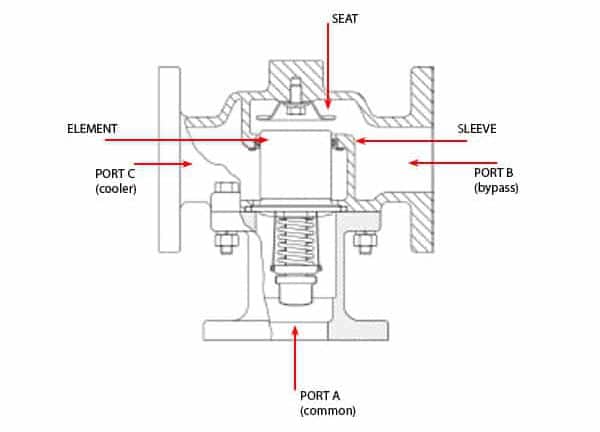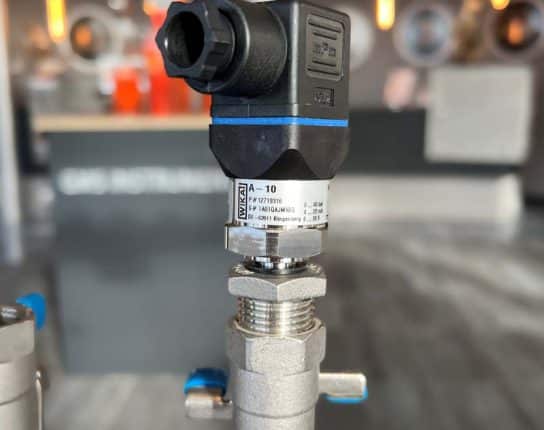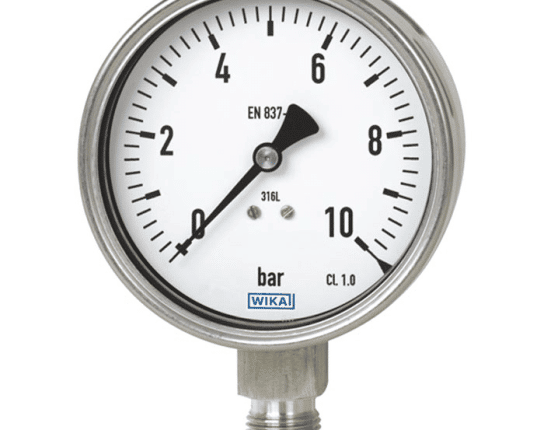
What is a temperature control valve? Explained in 5-steps
Temperature control valves are built to control fluid temperatures, i.e., turbines, compressors, engine jacket water and lubrication oil cooling systems. But what is a temperature control valve exactly, and what types of temperature valves are there to choose? In this monthly blog, we explain in five steps what a temperature control valve is and how to select the correct valve for your need.
Temperature control valves are suitable for process control, maritime and industrial applications where fluids must be mixed or diverted to achieve optimal temperatures. The valve may also be applied to cogeneration systems to control temperatures in the heat recovery loop, assuring proper engine cooling and maximizing heat recovery. All to help to provide the process with the optimal temperature and therefore preventing costly downtime.
Valves in different types of applications are most named after the number of ports they have. So, for instance, a 2-way valve has, as the name suggests, two ports. A 3-way valve has three ports, etc. The port of a valve is simply said the connection point of the valve from where fluid enters or leaves the valve.
1: How is the valves anatomy
All valves need an entry point and exit point for the fluids that run through them. No matter the number of ports, size, or flow rate. No exceptions for the temperature control valve. The temperature control valve can contain 2 or 3 ports making it a 2-way or 3-way valve. In this example, we take a 3-way thermostatic valve.
Let’s look at the inside of the valve. General speaking, we have the housings of the valve. This could be made out of stainless steel, steel cast iron, dunctile iron, aluminium or bronze. In the valve, each port is marked by a letter indicating the example flow. In this case, we are showing flanged housing. We can find the seat at the top of the valve, which helps “seal” port B when the set temperature is reached. Below the seat, you’ll find the sleeve. In the sleeve, the element is placed. The sleeve contains the O-ring.

AMOT model B thermostatic valve anatomy
This example contains one element. The element in a temperature valve arranges the preferred output flowing through port A in this example. The element shrinks or expands at the pre-set temperature. Deep inside the bottom of the valve element is the wax or thermostatic material; this part is connected with the piston, which is connected to the sidebars that are inside this barrel. This is the sliding valve. Valve elements are robust, almost impossible to pull by hand. The sliding part will control where the flow is going to go based on what is happening. The expansion of the wax will help slide the element and control the flow. The element is closed when the media is in “cold” or below the nominal temperature. When the wax gets heated, it will expand and push the sliding valve out, and the element will open.

Holes in valve element
In some cases, a small hole is drilled in the element of the temperature valve. This hole connects the standard port (A) to the valve’s cooler port (C). This hole always ensures a small flow rate between the ports. Also, it could help slow down the warm up cycle, preventing condensation and prevent, in extreme cases, freezing.
2: Types of temperature control valves
There are two types of temperature valves;
- Thermostatic valves
- Actuated valves
Thermostatic control valves
A valve that is actuated by internally sensing and controlling the fluid temperatures is called a thermostatic valve. This type of valve is self-contained without any external power source. The operating temperature range is determined by the chemical composition of the wax material and is pre-set in the factory or local distributor according to the engine or equipment manufacturer’s recommendations. Once the thermostatic element is calibrated to a set temperature, it cannot be changed unless a new element is installed. This rugged yet straightforward design prevents operators from accidentally running the equipment too hot or cold, leading to higher fuel consumption, costly repairs, and downtime.
Actuated control valves
In contrast to internally-sensing valves, an actuated control valve is usually part of a complete system that senses temperature changes using an external probe. The probe sends a signal to a control panel to open or close the valve ports using an external power source. Typical system types include electric, pneumatic, or a combination of both. Although more components are necessary for this type of valve to work, they do offer several benefits. First, they tend to be much more accurate, so if your application requires precise temperature control, this may be a better option. Second, unlike thermostatic valves, these systems allow flexible temperature range adjustment if operating conditions change. In this animated video by AMOT is shown how an actuated control valve operates.
3: How to use a thermostatic valve
Mixing Applications
When valves are used for mixing service, Port C is the cold fluid inlet from the cooler, Port B is the hot by-pass fluid inlet, and Port A is the standard outlet. Port A is the temperature sensing port and will mix the hot and cold fluids in the correct proportion to produce the desired outlet temperature leaving Port A.
Diverting Applications
When valves are used for diverting services, the inlet is Port A (temperature sensing port), with Port C being connected to the cooler and Port B connected to the cooler by-pass line.
4: How to choose the correct temperature valve
So, we know the difference between a thermostatic control valve and an actuated control valve; we can determine when to choose which temperature control valve. Whether your required valve needs to mixing fluids of different temperatures or diverting fluids to a cooler, heat exchanger, or radiator, both temperature valves work equally good under these circumstances. So the question regarding whether to choose a thermostatic temperature valve or an actuated temperature valve does the valve needs to be a ‘stand-alone’ and function on itself, or does the valve needs to be placed in a complete system that is controlled by temperature sensors. If there’s no external power source available, the choice is already made for you.
5: Service of temperature control valve
Because temperature valves are robust and housings made from durable materials, it does not mean service is not necessary. On the contrary, the better your valve is serviced and maintained, the better the quality of the valve, a smaller chance of downtime and a longer operational lifetime. The most vulnerable parts of a temperate valve are the soft parts. The soft parts of a valve include the seals and O-rings. We, therefore, recommend to service valve every 3 to 5 years or whenever you have a significant overhaul of the system. For AMOT valves, a unique control valve service kit can be supplied, including the soft parts and elements needed to service the valve fully.
Related
More of the same



